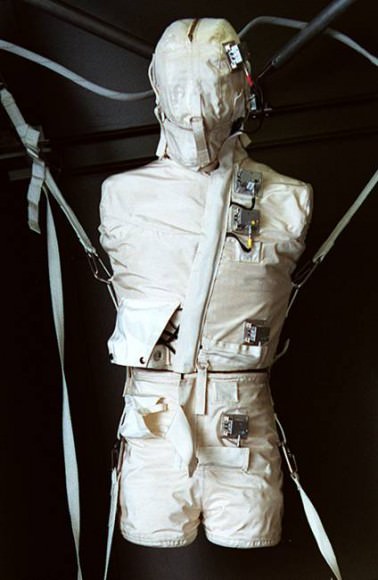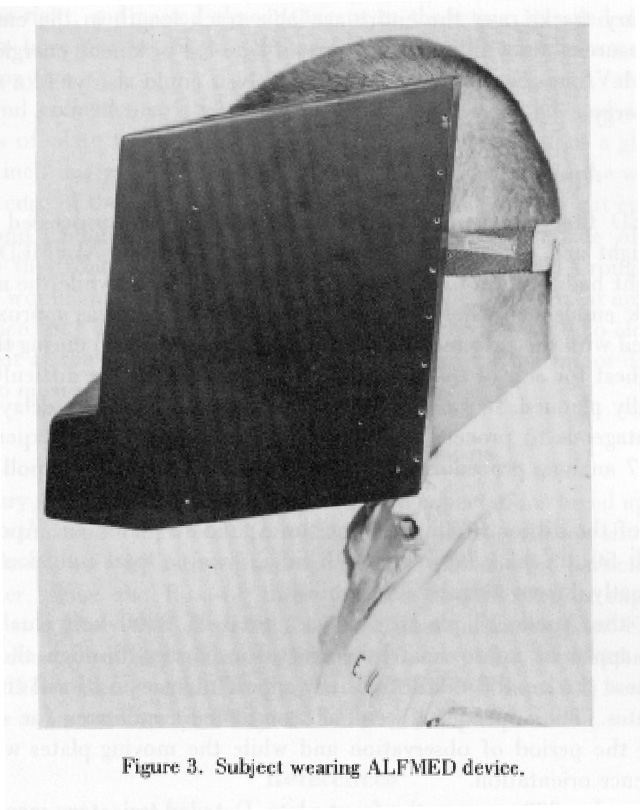Astronauts have long reported the experience of seeing flashes while they are in space, even when their eyes are closed. Neil Armstrong and Buzz Aldrin both reported these flashes during the Apollo 11 mission, and similar reports during the Apollo 12 and 13 missions led to subsequent Apollo missions including experiments specifically looking at this strange phenomenon. These experiments involved blindfolding crewmembers and recording their comments during designated observation sessions, and later missions had a special device, the Apollo Light Flash Moving Emulsion Detector (ALFMED), which was worn by the astronauts during dark periods to record of incidents of cosmic ray hits.
It was determined the astronauts were ‘seeing’ cosmic rays zipping through their eyeballs. Cosmic rays are high-energy charged subatomic particles whose origins are not yet known. Fortunately, cosmic rays passing through Earth are usually absorbed by our atmosphere. But astronauts outside the atmosphere can find themselves “seeing things that aren’t there,” wrote current International Space Station astronaut Don Pettit, who told about his experience of seeing these flashes on his blog:
“In space I see things that are not there. Flashes in my eyes, like luminous dancing fairies, give a subtle display of light that is easy to overlook when I’m consumed by normal tasks. But in the dark confines of my sleep station, with the droopy eyelids of pending sleep, I see the flashing fairies. As I drift off, I wonder how many can dance on the head of an orbital pin.”
In a report on the Apollo experiment, astronauts described the types of flashes they saw in three ways: the ‘spot’, the ‘streak’, and the ‘cloud’; and all but one described the flashes as ‘white’ or ‘colorless.’ One crewmember, Apollo 15 Commander David Scott, described one flash as “blue with a white cast, like a blue diamond.”
Pettit described the physics/biology of what takes place:
“When a cosmic ray happens to pass through the retina it causes the rods and cones to fire, and you perceive a flash of light that is really not there. The triggered cells are localized around the spot where the cosmic ray passes, so the flash has some structure. A perpendicular ray appears as a fuzzy dot. A ray at an angle appears as a segmented line. Sometimes the tracks have side branches, giving the impression of an electric spark. The retina functions as a miniature Wilson cloud chamber where the recording of a cosmic ray is displayed by a trail left in its wake.”
Pettit said that the rate or frequency at which these flashes are seen varies with orbital position.
“There is a radiation hot spot in orbit, a place where the flux of cosmic rays is 10 to 100 times greater than the rest of the orbital path. Situated southeast of Argentina, this region (called the South Atlantic Anomaly) extends about halfway across the Atlantic Ocean. As we pass through this region, eye flashes will increase from one or two every 10 minutes to several per minute.

During the Apollo missions, astronauts saw these flashes after their eyes had become dark-adapted. When it was dark, they reported a flash every 2.9 minutes on average. Only one Apollo crewmember involved in the experiments did not report seeing the phenomenon, Apollo 16’s Command Module Pilot Ken Mattingly, who stated that he had poor night vision.
These cosmic rays don’t just hit people, but things in space, too, and sometimes cause problems. Pettit wrote:
“Free from the protection offered by the atmosphere, cosmic rays bombard us within Space Station, penetrating the hull almost as if it was not there. They zap everything inside, causing such mischief as locking up our laptop computers and knocking pixels out of whack in our cameras. The computers recover with a reboot; the cameras suffer permanent damage. After about a year, the images they produce look like they are covered with electronic snow. Cosmic rays contribute most of the radiation dose received by Space Station crews. We have defined lifetime limits, after which you fly a desk for the rest of your career. No one has reached that dose level yet.”

There are experiments on board the ISS to monitor how much radiation the crew is receiving. One experiment is the Phantom Torso, a mummy-looking mock-up of the human body which determines the distribution of radiation doses inside the human body at various tissues and organs.
There’s also the Alpha Magnetic Spectrometer experiment, a particle physics experiment module that is mounted on the ISS. It is designed to search for various types of unusual matter by measuring cosmic rays, and hopefully will also tell us more about the origins of both those crazy flashes seen in space, and also the origins of the Universe.
A tall order!


I felt that mentioning the South Atlantic Anomaly without explaining it was unfair, smacks of teasing the reader, and left the article too superficial.
So I looked it up.
Good idea, and thanks!
Something is not kosher though. The CR shouldn’t be so dependent on the lack of Earth magnetic field protection. There may be many contributions, as the article implies by not tying them to anything in particular.
One indirect CR contribution would be from the bottled up antiprotons of the van Allen belts spilling over there at times.
And people are in a rush to fly to Mars.. there’s still so much more we don’t know.
That last image looks rather… kinky
Torso 2 Is like a Doom Boos
We haven’t heard much from the Alpha Magnetic Spectrometer experiment, or at least very little. Any progress report would be appreciated…
I’m thrilled to see that it doesn’t harm anyone below the knees. 😉
I’ve always wanted to build this Tesla machine to see if it works, but I think if we consider that no astronaut has yet reached a lifetime limit of cosmic radiation, we can assume that this machine probably doesn’t work.
http://home.earthlink.net/~drestinblack/generator.htm